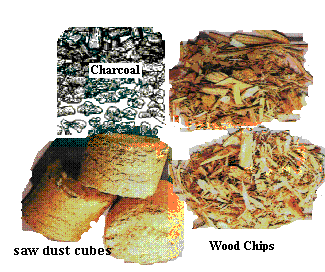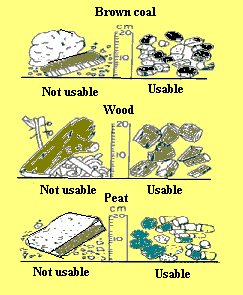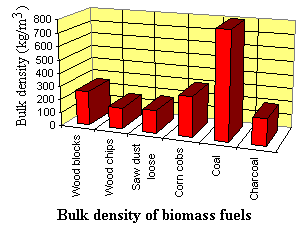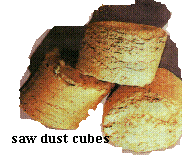 A wide range of biomass fuels such as wood, charcoal, wood waste (branches, roots, bark, saw dust) as well agricultural residues- maize cobs, coconut shells, cereal straws, rice husks, can be used as fuel for biomass gasification. Theoretically, almost all kinds of biomass with moisture content of 5-30% can be gasified; however, not every biomass fuel lead to the successful gasification. Most of the development work is carried out with common fuels such as coal, charcoal and wood. Key to a successful design of gasifier is to understand properties and thermal behaviour of fuel as fed to the gasifier. The properties of fuel which influnce the gasification are described below.
A wide range of biomass fuels such as wood, charcoal, wood waste (branches, roots, bark, saw dust) as well agricultural residues- maize cobs, coconut shells, cereal straws, rice husks, can be used as fuel for biomass gasification. Theoretically, almost all kinds of biomass with moisture content of 5-30% can be gasified; however, not every biomass fuel lead to the successful gasification. Most of the development work is carried out with common fuels such as coal, charcoal and wood. Key to a successful design of gasifier is to understand properties and thermal behaviour of fuel as fed to the gasifier. The properties of fuel which influnce the gasification are described below.
- Energy content
- Moisture content
- Particle size and distribution
- Form of the fuel
- Bulk density of the fuel
- Volatile matter content
- Ash content and composition
- Reactivity of the fuel
Energy content of fuel
 Energy content of fuel is obtained in most cases in an adiabatic, constant volume bomb calorimeter. The values obtained are higher heating values which include the heat of condensation from water formed in the combustion of fuel. The heating values are also reported on moisture and ash basis. Fuel with higher energy content is always better for gasification. The most of the biomass fuels (wood, straw) has heating value in the ragne of 10-16 MJ/kg, whereas liquid fuel (diesel, gasoline) posses higher heating value.
Energy content of fuel is obtained in most cases in an adiabatic, constant volume bomb calorimeter. The values obtained are higher heating values which include the heat of condensation from water formed in the combustion of fuel. The heating values are also reported on moisture and ash basis. Fuel with higher energy content is always better for gasification. The most of the biomass fuels (wood, straw) has heating value in the ragne of 10-16 MJ/kg, whereas liquid fuel (diesel, gasoline) posses higher heating value.Fuel moisture content
 The moisture content of the most biomass fuel depends on the type of fuel, itīs origin and treatment before it is used for gasification. Moisture content of the fuel is usually referred to inherent moisture plus surface moisture. The moisture content below 15% by weight is desirable for trouble free and economical operation of the gasifier. Higher moisture contents reduce the thermal efficiency of gasifier and results in low gas heating values. Igniting the fuel with higher moisture content becomes increasingly difficult, and the gas quality and the yield are also poor .
The moisture content of the most biomass fuel depends on the type of fuel, itīs origin and treatment before it is used for gasification. Moisture content of the fuel is usually referred to inherent moisture plus surface moisture. The moisture content below 15% by weight is desirable for trouble free and economical operation of the gasifier. Higher moisture contents reduce the thermal efficiency of gasifier and results in low gas heating values. Igniting the fuel with higher moisture content becomes increasingly difficult, and the gas quality and the yield are also poor .Particle size and distribution
 The fuel size affect the pressure drop across the gasifier and power that must be supplied to draw the air and gas through gasifier. Large pressure drops will lead to reduction of the gas load in downdraft gasifier, resulting in low temperature and tar production. Excessively large sizes of particles give rise to reduced reactivity of fuel, causing start-up problem and poor gas quality.
The fuel size affect the pressure drop across the gasifier and power that must be supplied to draw the air and gas through gasifier. Large pressure drops will lead to reduction of the gas load in downdraft gasifier, resulting in low temperature and tar production. Excessively large sizes of particles give rise to reduced reactivity of fuel, causing start-up problem and poor gas quality. Acceptable fuel sizes depend to certain extent on the design of gasifier. In general, wood gasifier work well on wood blocks and wood chips ranging from 80x40x40 mm to 10x5x5 mm. For charcoal gasifier, charcoal with size ranging from 10x10x10 mm to 30x30x30 mm is quite suitable.
Bulk density of fuel
 Bulk density is defined as the weight per unit volume of loosely tipped fuel. Bulk density varies significantly with moisture content and particle size of fuel. Volume occupied by stored fuel depends on not only the bulk density of fuel, but also on the manner in which fuel is piled. It is also recognised that bulk density has considerable impact on gas quality, as it influences the fuel residence time in the fire box, fuel velocity and gas flow rate.
Bulk density is defined as the weight per unit volume of loosely tipped fuel. Bulk density varies significantly with moisture content and particle size of fuel. Volume occupied by stored fuel depends on not only the bulk density of fuel, but also on the manner in which fuel is piled. It is also recognised that bulk density has considerable impact on gas quality, as it influences the fuel residence time in the fire box, fuel velocity and gas flow rate. Fuel form
 The form in which fuel is fed to gasifier has an economical impact on gasification. Densifying biomass has been practiced in the US for the past 40 years. Cupers and Pelletizers densify all kinds of biomass and municipal waste into " energy cubes". These cubes are available in cylindrical or cubic form and have a high density of 600-1000 kg/m 3 The specific volumetric content of cubes is much higher than the raw material from which they are made.
The form in which fuel is fed to gasifier has an economical impact on gasification. Densifying biomass has been practiced in the US for the past 40 years. Cupers and Pelletizers densify all kinds of biomass and municipal waste into " energy cubes". These cubes are available in cylindrical or cubic form and have a high density of 600-1000 kg/m 3 The specific volumetric content of cubes is much higher than the raw material from which they are made.Volatile matter content of fuel
Volatite matter and inherantly bound water in the fuel are given up in pyrolyis zone at the temperatures of 100-150 o c forming a vopour consisting of water, tar, oils and gases. Fuel with high volatile matter content produces more tar, causing problems to internal combustion engine. Volatile matters in the fuel determine the design of gasifier for removal of tar. Compared to other biomass materials (crop residue : 63-80 %, Wood : 72-78 %, Peat : 70 %, Coal: upto 40 % ), charcoal contains least percentage of volatile matter (3-30 %)
Ash content of fuel
Mineral contents of fuel which remians in oxidized form after combustion of fuel is called ash. In practice, ash also contain some unburned fuel. Ash content and ash composition have impact on smooth running of gasifier. Melting and agglormeration of ashes in reactor causes slagging and clinker formation. If no measures are taken, slagging or clinker formation lead to excessive tar formation or complete blocking of reactor. In general, no slagging occurs with fuel having ash content below 5 %. Ash content varies fuel to fuel. Wood chips has contains 0.1% ash, while rice hust contains high amount of ash (16-23%)
Fuels and their ash content
| Fuel | Ash content % weight | Fuel | Ash content % weight |
|---|---|---|---|
| Alfalfa seed straw | 6.0 | peanut husks | 0.9 |
| Barley straw | 10.3 | Rice hulls | 16-23 |
| Charcoal | 2-5 | Safflower straw | 6.0 |
| Coffee hulls | 1.3 | Wallnut shell | 1.1 |
| Coal | 5-17 | Wheat stalks | 7.4 |
| Cotton grin thrash | 17.2 | Wood chips | 0.1 |
Reactivity of fuel
Reactivity determines the rate of reduction of carbon dioxide to carbon monoxide in the gasifier. Reactivity depends upon the type of fuel. It has found that wood and charcoal are more reactive than coal. There is relationship between reactivity and the number of active places on the char surfaces.
It is well known fact that reactivity of char surface can be improved through various processes including stream treatment (activated carbon) or treatment with lime and sodium carbonate. There are number of elements which act as catalyst and influence the gasification process. Small quantities of potassium, sodium and zink can have large influence on reactivity of the fuel.
To retun to main page click here